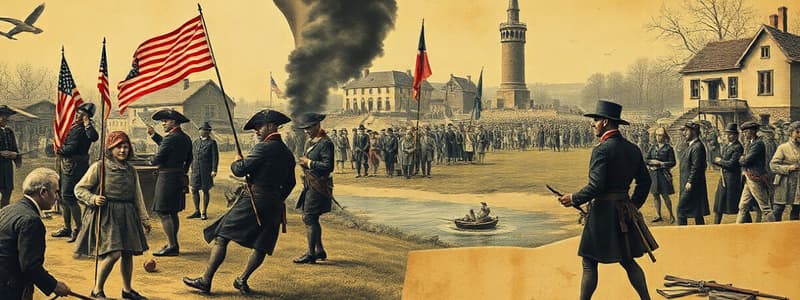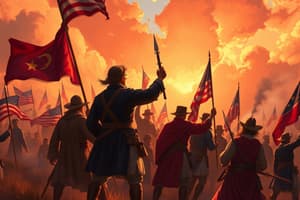Podcast
Questions and Answers
Which of the following best describes the significance of the Mayflower Compact?
Which of the following best describes the significance of the Mayflower Compact?
- It established the principle of religious freedom in the colonies.
- It was the first written framework for self-government in the colonies. (correct)
- It formally declared the colonies' independence from Great Britain.
- It outlined the economic policies for the Southern colonies.
How did the Intolerable Acts contribute to the outbreak of the American Revolution?
How did the Intolerable Acts contribute to the outbreak of the American Revolution?
- They were seen as a direct attack on colonial liberties, increasing colonial unity against British rule. (correct)
- They successfully resolved tensions between colonists and Native Americans.
- They strengthened the colonial economy by increasing trade with Great Britain.
- They granted colonists more representation in the British Parliament.
What was the primary weakness of the Articles of Confederation that led to the Constitutional Convention?
What was the primary weakness of the Articles of Confederation that led to the Constitutional Convention?
- The Articles gave too much power to the executive branch.
- The Articles created a strong national government that oppressed the states.
- The Articles did not provide a strong central government capable of effectively governing the nation. (correct)
- The Articles lacked a national court system.
How did the Louisiana Purchase impact the United States?
How did the Louisiana Purchase impact the United States?
What was the main goal of the Seneca Falls Convention?
What was the main goal of the Seneca Falls Convention?
Which of the following was a significant result of the War of 1812?
Which of the following was a significant result of the War of 1812?
Which event is considered the start of the Civil War?
Which event is considered the start of the Civil War?
How did the Black Codes affect African Americans during Reconstruction?
How did the Black Codes affect African Americans during Reconstruction?
Flashcards
Colonization
Colonization
European countries explored and settled in North America.
Transatlantic Slave Trade
Transatlantic Slave Trade
A system of trade where enslaved Africans were forcibly transported to the Americas.
Mayflower Compact
Mayflower Compact
Document establishing self-government among the Pilgrims.
Declaration of Independence
Declaration of Independence
Signup and view all the flashcards
Articles of Confederation
Articles of Confederation
Signup and view all the flashcards
Manifest Destiny
Manifest Destiny
Signup and view all the flashcards
Jim Crow Laws
Jim Crow Laws
Signup and view all the flashcards
13th, 14th, 15th Amendments
13th, 14th, 15th Amendments
Signup and view all the flashcards
Study Notes
- 8th grade U.S. History typically spans from colonization to Reconstruction.
Exploration and Colonization (1492–1763)
- European exploration was spearheaded by figures like Columbus and explorers from Spain, France, and England.
- The English established 13 colonies along the east coast of what would become the United States.
- Colonial life and economy differed significantly between the New England, Middle, and Southern Colonies.
- Colonists interacted with Native Americans, often resulting in conflict and displacement.
- The Transatlantic Slave Trade led to the forced migration of Africans to the Americas via the Middle Passage.
- Early forms of self-government emerged, such as the Mayflower Compact and the House of Burgesses.
American Revolution (1763–1783)
- The Revolution was fueled by grievances over taxation, protests, and acts like the Boston Tea Party and Intolerable Acts.
- Key figures include George Washington, Thomas Jefferson, Benjamin Franklin, and King George III.
- The Declaration of Independence was adopted in 1776, formally proclaiming the colonies' separation from Britain.
- Major battles included Lexington & Concord, Saratoga, and Yorktown.
- The Treaty of Paris in 1783 officially ended the war, recognizing American independence.
The Constitution and Early Government (1783–1800)
- The Articles of Confederation suffered from significant weaknesses, prompting its replacement.
- The Constitutional Convention produced the Great Compromise and the 3/5 Compromise to resolve disputes over representation.
- Federalists and Anti-Federalists debated the merits of the new Constitution.
- The Bill of Rights was added to the Constitution to protect individual liberties.
- George Washington set important precedents as the first president, outlined in his Farewell Address.
- Political parties emerged, most notably the Federalists and Democratic-Republicans.
The New Nation & Westward Expansion (1800–1850s)
- The Louisiana Purchase in 1803 doubled the size of the United States and was explored by the Lewis & Clark Expedition.
- The War of 1812 was caused by British violations of American maritime rights; its effects included a surge in nationalism.
- The Monroe Doctrine declared U.S. opposition to European interference in the Americas.
- The Industrial Revolution brought significant economic and social changes.
- Westward expansion was driven by Manifest Destiny, leading to events like the Trail of Tears, Texas Independence, the Oregon Trail, and the Gold Rush.
Sectionalism and Reform Movements (1820s–1850s)
- The Missouri Compromise attempted to address the growing divide over slavery.
- The Abolitionist Movement, led by figures like Frederick Douglass and Harriet Tubman, sought to end slavery through efforts like the Underground Railroad.
- The Women’s Rights Movement advocated for gender equality, with key events like Seneca Falls and leaders like Susan B. Anthony.
- Reform movements also targeted temperance, education, and prison reform.
The Civil War (1861–1865)
- The Civil War was caused by disagreements over slavery, states’ rights, and sectionalism.
- Key events included the attack on Fort Sumter, the Emancipation Proclamation, and the Battle of Gettysburg.
- Important leaders included Abraham Lincoln, Ulysses S. Grant, Robert E. Lee, and Jefferson Davis.
- The war had profound effects on American society, politics, and the economy.
Reconstruction (1865–1877)
- The 13th Amendment abolished slavery, the 14th Amendment granted citizenship and equal protection, and the 15th Amendment protected voting rights.
- The Freedmen’s Bureau was established to assist formerly enslaved people.
- Black Codes and Jim Crow Laws were enacted to restrict the rights of African Americans.
- Reconstruction plans varied, including Lincoln’s Plan, Johnson’s Plan, and Radical Reconstruction.
- The Compromise of 1877 effectively ended Reconstruction, leading to the withdrawal of federal troops from the South.
Studying That Suits You
Use AI to generate personalized quizzes and flashcards to suit your learning preferences.
Description
Overview of U.S. History from 1492-1783, covering European exploration, colonization, and the American Revolution. Key events include the establishment of 13 colonies, interactions with Native Americans, the Transatlantic Slave Trade, and early forms of self-government.




